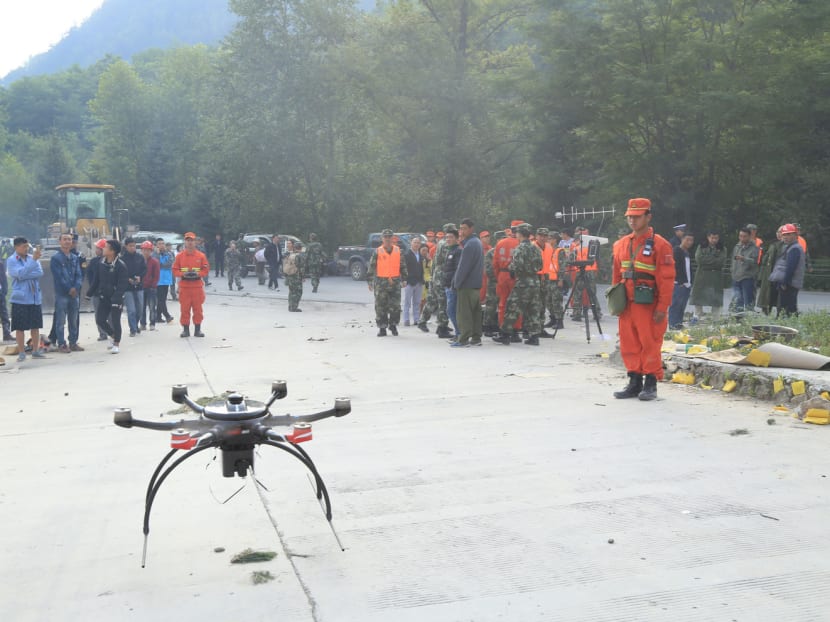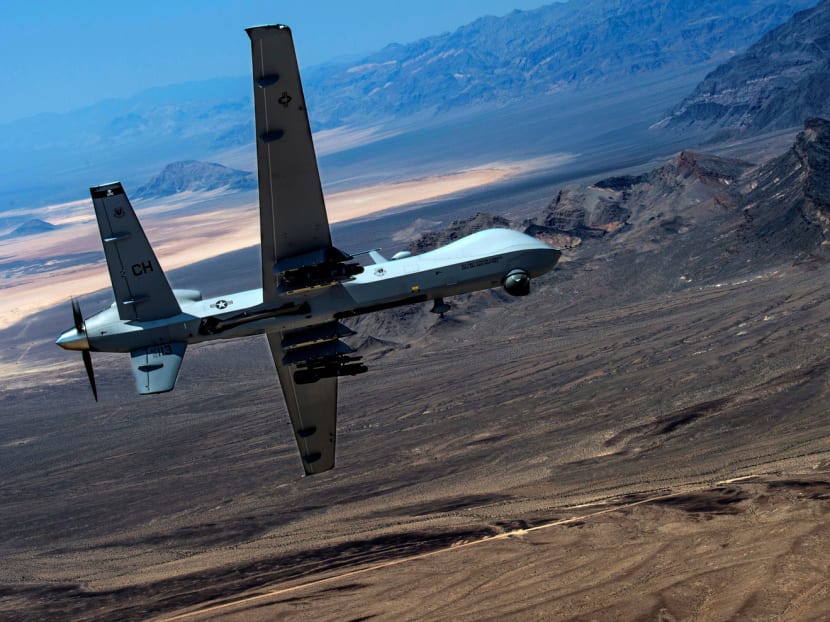Strength in numbers: Chinese military explores drone swarms
BEIJING — With their tiny propellers buzzing, the fleet of Chinese aircraft, little larger than model planes, is flung into the air one at a time by huge rubber bands. Soon, the sky is full of toylike drones flying in formations over unidentified mountains in China.


BEIJING — With their tiny propellers buzzing, the fleet of Chinese aircraft, little larger than model planes, is flung into the air one at a time by huge rubber bands. Soon, the sky is full of toylike drones flying in formations over unidentified mountains in China.
This unlikely spectacle could represent a Revolution in Military Affairs (RMA). The June 11 demonstration of “swarm” technology by China Electronics Technology Group Corporation (CETC), a state-owned high-tech company, included 119 drones. That made it the world’s largest-ever swarm, according to CETC, breaking a US-held record.
Each tiny aircraft — bought online for a few hundred dollars — is loaded with software and sensors capable of communicating with the other drones in the swarm. Developers are working towards a future where thousands could operate in sync, identifying and attacking targets. In theory, such swarms could feature drones fitted with missiles or warheads capable of sophisticated attacks designed to overwhelm defences with their sheer numbers.
“This goes all the way back to the tactics of Attila the Hun,” says Mr Randall Steeb, senior engineer at the Rand Corporation in the United States. “A light attack force that can defeat more powerful and sophisticated opponents. They come out of nowhere, attack from all sides and then disappear, over and over.”
China’s two-decade effort to modernise its military has seen it develop stealth fighters, guided missile destroyers and ballistic “carrier killer” missiles, while also reducing troop numbers. It will spend at least US$152 billion (S$206bn) this year on its military, but only in a few areas has it come close to surpassing US technology. Beijing is now betting that swarms of drones, low-tech hardware knitted together with high-tech artificial intelligence, will become the weapon of the future.
The gamble is that they can be effective both as a lethal and non-lethal weapon. Thousands of cheap 3D-printed drones, for example, could swarm aircraft carriers or fighter jets, which currently have no countermeasures for such attacks. They can also be effective, say experts, without being lethal by crossing the line into a shooting war — a valuable form of deterrence, especially for weaker countries.
For example, swarms of autonomous boats could appear when a US ship sails close to a disputed island in the South China Sea and block its path. Referred to by the US military as “grey-zone threats”, they could leave a superior military with a dilemma about how to respond without appearing to be the aggressor.
“Swarming is currently considered to be one of the most promising areas of defence technology development in the world,” says Mr Vasily Kashin, an expert on China’s military at the Higher School of Economics in Moscow. “The Chinese are prioritising it.”
As is Washington. “Clearly the US and China are in some sort of weird swarm race,” says Mr Paul Scharre, a senior fellow at the Centre for a New American Security who writes on military robotics. “A swarm with 10 more individual drones isn’t necessarily better. What matters are the things you can’t see. It’s the algorithms that govern the swarm behaviour.”
China insists it is now on an even footing with the US on drones, with CETC saying it has “made some major breakthroughs”.
But experts warn that mature swarm technology is still a long way off and will require developing the necessary technology to boost communication between the drones, methods to keep them in the air longer and a modern military capable of deploying the swarms effectively.
It is hard to assess the claim that China’s technology is superior to that of the US, says Mr Scharre. The US military operates about 7,000 drones. Analysts say there could be at least 1,300 currently in operation between the Chinese army and air force, although none have been used in offensive missions.
However, Chinese-made drones have seen combat in war zones around the world, in the hands of importers such as Iraq and Saudi Arabia. These drones are not autonomous, however, and require aircrews of at least three to operate them.
Swarms take the might of drones a step further. “The essence of a swarm is co-operation,” adds Mr Scharre. “Having a hundred or a thousand small cheap drones that can’t communicate and co-ordinate behaviour isn’t worth much. What’s valuable is if they can communicate and work cooperatively. That’s a difference between a wolf pack and just little wolves.”
The past 25 years have witnessed a period of US military dominance built on advanced technology in areas such as stealth and precision weaponry.
The US, which outspends China, its closest rival in military spending, by nearly four times, retains primacy through small numbers of highly sophisticated weapons. But as laggards catch up with cruise missiles and stealth fighters of their own, the US has been focused on even newer technologies. That has driven a new era in weaponry, where robotics, directed energy weapons and 3D-printed kit will feature on the battlefields of the future.
The advent of swarm technology heralds a period that could reverse the trend of the past quarter of a century, which has seen the deployment of fewer but more advanced — and expensive — weapons platforms. The next generation of weapons may see sophisticated technology systems outdone by the sheer numbers of autonomous swarms.
“The result (of swarm technology) will be a paradigm shift where mass once again becomes the decisive factor on the battlefield, where having the most intelligent algorithm may be more important than having the best hardware,” says Mr Scharre.
The US has prioritised expensive, highly advanced hardware such as Global Hawk drones that require a team of dozens to keep them in the air.
The advantage of swarms is that they require comparatively low-tech hardware knitted together with advanced software.
Some in China see robotics as part of an asymmetric warfare in which an opponent whose overall capabilities are regarded as technologically inferior can defeat a superior one.
“The People’s Liberation Army anticipates that swarm intelligence and swarming tactics could serve as an asymmetric means to target high-value US weapons platforms,” says Ms Elsa Kania, an independent researcher on Chinese military affairs.
This is creating tensions within the ranks of China’s defence establishment, where the competition for resources and funding is intense amid a radical overhaul of the services. Military leaders want expensive planes and ships that rival American weapons.
But a growing faction within the PLA favours committing more resources to next-generation weapons.
Mr Wang Weixing, a military research director at the PLA, is one of a number who argue that Beijing’s focus on matching the US in technology — stealth fighters, carrier killer missiles, aircraft carriers — is wrong and that it should adopt an “asymmetric” strategy focused on drones.
“As people are still preparing for a high-tech war, the old and new are becoming intertwined to become a new form of hidden complex ‘hybrid war’,” he wrote in June in a front-page commentary in the PLA Daily, the military’s flagship publication.
“Unmanned combat is gradually emerging. While people have their heads buried in the sand trying to close the gap with the world’s military powers in terms of traditional weapons, technology-driven ‘light warfare’ is about to take the stage.”
China, which is at the centre of the commercial drone industry, has some advantages as the era of unmanned systems dawns.
Manufacturers such as DJI, Zerotech and Ehang dominate the global consumer drone industry and many of these private sector companies have been co-opted to work for the PLA.
“It is increasingly blurred what is civilian and what is military, especially in areas like UAVs (unmanned aerial vehicles),” says Mr Tai Ming Cheung, director of the Institute on Global Conflict and Co-operation at the University of California, San Diego. For example, the drone used by CETC in the June swarm demonstration was the X-6 Skywalker, a commercial model that can be easily customised.
One US drone engineer, who asked not to be named, said: “If the military advantage is going to the country that can make the largest amounts of cheap commodity electronics, then watch out for China.”
Chinese leaders have trumpeted technological advances even as the country’s armed forces plan to shed 300,000 personnel by 2018, becoming more streamlined and combat-ready. Autonomously operating swarms would require far fewer active troops.
Swarm technology, according to defence experts, is attractive to Beijing as it would allow China to project force with a lower probability of military confrontation.
Drones, unlike fighter jets or aircraft carriers, are less threatening and can be shot down or captured without triggering a military escalation.
In December, China seized a US underwater drone in the South China Sea, which the PLA then handed back after a few days. This would have triggered a major crisis had it been a manned vehicle.
China is also pushing into other areas of robot technology including an imitation of Boston Dynamics’ “Big Dog” troop support robot, which resembles something out of Star Wars and is designed to carry equipment into battle. Developed by arms conglomerate Norinco, Mr Kashin likens it to “a US$1 million donkey”.
Yunzhou Tech Corporation, based in Zhuhai, displayed an unmanned boat armed with a machine gun turret at a military technology exhibition in Beijing last month. A Chinese website recently published photos of a torpedo-carrying autonomous vehicle that skims the surface of the water. The product could be used to target submarines. “These are not like anything anyone else has,” says Mr Kashin.
“China has come a long way in its development of unmanned systems in a relatively short period,” says Mr Michael Chase, a senior political scientist at the Rand Corporation.
Mr Jack Midgley of Deloitte’s defence consulting practice says that, judging by China’s poor record of integrating technologies and new organisational models, the inherently conservative attitude of its military may put it at a disadvantage. “The natural risk aversion of military commanders is why it takes years or decades to integrate new technologies,” he says.
China is not alone in this — some service branches in the US are also resistant to drones taking away human roles such as pilots.
But Beijing’s attitude to new defence technology may be evolving. In 2001, the PLA created its first training curriculum for UAV personnel. Today, at least three out of the five PLA branches, the army, navy and air force, have incorporated UAV units into their operations and training.
“The PLA may not have as many qualms (as the US) about having UAVs become a much larger part of its war structure,” says Ms Kania.
Ultimately, she says, it is not the country that invents the latest technology, but the one that figures out how best to integrate it on the battlefield that will have the most success. The new arms race may not be about driving technological change, so much as adapting to it. FINANCIAL TIMES








